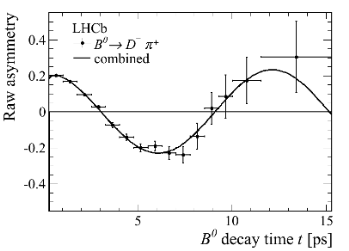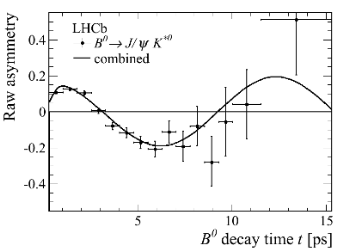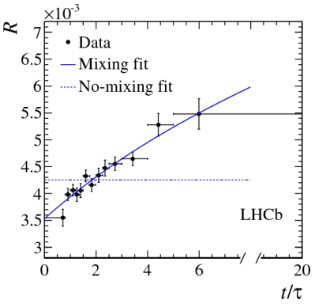[ Δmd = 0.5156 ± 0.0051 ± 0.0033 ps-1 ]
[ x’2 = (-0.9 ± 1.3)x10-4 ; y’ = (7.2 ± 2.4)x10-3 ]
A fascinating feature of quantum mechanics has been reported 15 March 2011 on this page. The strange beauty particle (matter) B0s composed of a beauty antiquark (b) bound with a strange quark s turns into its antimatter partner composed of a b quark and an s antiquark (s) with a frequency of about 3 million million times per second (3*1012). This feature is called “oscillations” or “mixing”. The LHCb Collaboration has just published the first observation of similar oscillations of charm mesons D0 composed of a charm quark and an anti-up quark (D0-D0 oscillations) and the most precise measurement of a parameter defining the frequency of the oscillations of beauty mesons B0 composed of a beauty antiquark (b) bound with a d quark (B0-B0 oscillations).
The B0 decays into D+π– and J/ψK*0 were used to study B0-B0 oscillations. The images below show the asymmetry which is proportional to the difference between the number of events in which the matter (or antimatter) B0 particle decayed with the same flavour identity with which it was produced, and the number of events in which it did not, as a function of its lifetime. The B0-B0 oscillations are clearly visible. LHCb physicists have parametrized them with a value Δmd = 0.5156 ± 0.0051 ± 0.0033 ps-1 corresponding to the frequency of about 80 thousand million times per second (8*1010), about 37 times slower than B0s-B0s oscillations. The B0-B0 oscillations have been previously measured at LEP, Tevatron and B factories. The LHCb result is currently the most precise measurement of the Δmd parameter.
click the image for higher resolution
D0-D0 oscillations are very slow, over one hundred times the average lifetime of a D0 meson, so the full oscillation period cannot be observed. Instead, it is necessary to look for small changes in the flavour mixture (matter or antimatter) of the D0 mesons as a function of the time at which they decay. One of the best channels to search for this mixing is the D0 decay to the Kπ final state. The initial matter-antimatter identity can be identified by the charge of the accompanying pion in the decay D*+→D0π+ or D*-→D0π–. The mixing effect (oscillation) appears as a decay-time dependence of the ratio R between the number of reconstructed “wrong-sign” (WS; D0→K+π–) and “right-sign” (RS; D0→K–π+) processes. In the absence of mixing, R is predicted to be constant as a function of the D0 decay time t, while, in case of mixing, it is predicted to be an approximately parabolic function of t. The left image below shows the WS over RS ratio R, as a function of decay time, from a total of 36 thousand WS and 8.4 million RS decays selected from the 1.0 fb-1 of data recorded in 2011. The horizontal dashed line shows the no-mixing hypothesis, the solid line is the best fit to data when mixing is allowed. The clear time dependence observed excludes the no-mixing hypothesis by 9.1 σ.
click the image for higher resolution
Comparison of values parameterizing the D0-D0 oscillations, y’ and x’2, obtained by different experiments, are presented in right image above. The LHCb results exclude the no-mixing hypothesis by more than 5 σ for the first time and therefore can be classified as the first observation of this effect.
Since the Standard Model predictions for the mixing parameters have large uncertainties, the next step will be to focus on cleaner observables to search for possible new physics contributions. In particular, LHCb is now well placed to investigate whether there is a CP violating contribution to the oscillations, in contrast to the Standard Model expectation. This will be achieved by studying charm mixing in this and other decay channels and exploiting the large increase in available statistics following the successful 2012 LHC run.
Read more in the LHCb publications: D0-D0 and B0-B0 oscillations, in the CERN Courier article and in the USLHC Quantum Diaries blog.




